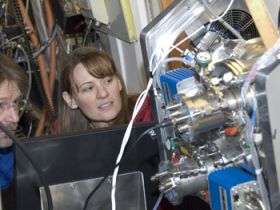NASA Launches Airborne Study of Arctic Atmosphere, Air Pollution

NASA Launches Airborne Study of Arctic Atmosphere, Air Pollution WASHINGTON -- This month, NASA begins the most extensive field campaign ever to investigate the chemistry of the Arctic's lower atmosphere. The mission is poised to help scientists identify how air pollution contributes to climate changes in the Arctic.
The recent decline of sea ice is one indication the Arctic is undergoing significant environmental changes related to climate warming. NASA and its partners plan to investigate the atmosphere's role in this climate-sensitive region with the Arctic Research of the Composition of the Troposphere from Aircraft and Satellites (ARCTAS) field campaign.
"It's important that we go to the Arctic to understand the atmospheric contribution to warming in a place that's rapidly changing," said Jim Crawford, manager of the Tropospheric Chemistry Program at NASA Headquarters in Washington. "We are in a position to provide the most complete characterization to date for a region that is seldom observed but critical to understanding climate change."
The campaign begins this week in Fairbanks, Alaska. NASA's DC-8, P-3 and B-200 aircraft will serve as airborne laboratories for the next three weeks, carrying instruments to measure air pollution gases and aerosols and solar radiation. Of particular interest is the formation of the springtime "arctic haze." The return of sunlight to the Arctic in the spring fuels chemical reactions of pollutants that have accumulated over the winter after travelling long distances from lower latitudes.
"The Arctic is a poster child of global change and we don't understand the processes that are driving that rapid change," said Daniel Jacob, an ARCTAS project scientist at Harvard University, Cambridge, Mass. "We need to understand it better and that's why we're going."
ARCTAS is NASA's contribution to an international series of Arctic field experiments that is part of the International Polar Year. The National Oceanic and Atmospheric Administration and the Department of Energy also are sponsoring research flights from Fairbanks this month in collaboration with NASA.
The wealth of data collected also will improve computer models used to study global atmospheric chemistry and climate. This ultimately will provide scientists with a better idea of how pollutants are transported to and around the Arctic and their impact on the environment and climate.
"We haven't looked at pollution transport in a comprehensive fashion," said Hanwant Singh, an ARCTAS project scientist at NASA Ames Research Center, Moffett Field, Calif. "We can see Arctic haze coming in but we don’t know its composition or how it got there. One goal of ARCTAS is to provide a comprehensive understanding of the aerosol composition, chemistry and climate effects in the Arctic region."
The new aircraft observations also will help researchers interpret data from NASA satellites orbiting over the Arctic, such as Aura, Terra, and Cloud-Aerosol Lidar and Infrared Pathfinder Satellite Observation (CALIPSO). Interpreting satellite data can be difficult in the Arctic because of extensive cloud cover, bright reflective surfaces from snow and ice, and cold surface temperatures. For example, it's difficult for researchers to look at satellite data and distinguish between light reflected by clouds and light reflected from white ice cover.
"NASA has invested a lot of resources in satellites that can be of value for diagnosing effects of climate change,” Jacob said. "Satellites orbit over poles with good coverage and good opportunity, but you really need to have aircraft observations supporting those to make good interpretations of what satellites are telling you."
The new airborne view of the Arctic atmosphere combined with satellite data will provide scientists with a better understanding of the atmospheric side of the climate question.
"We're interested in data that will help models better characterize the current state of the atmosphere, to set a benchmark for them so we can gain confidence in their ability to predict future warming in the Arctic," Crawford said.
A second phase of the ARCTAS campaign takes place this summer from Cold Lake in Alberta, Canada, where flights will focus on measurements of emissions from forest fires. Researchers want to know how the impact of naturally occurring fires in the region compares to the pollution associated with human activity at lower latitudes. Understanding the relative influence of each is important to predictions of the Arctic's future climate.
Source: NASA




















